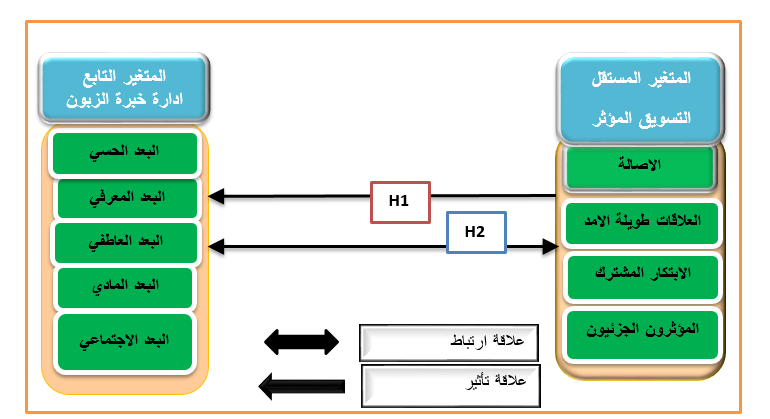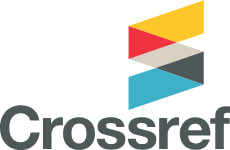The role of influencer marketing in enhancing customer experience management
An analytical of the opinions of a sample of managers of telecommunications companies in Iraq
Keywords:
customer experience management, influencer marketingAbstract
The study mainly aims to determine the role of influential marketing in enhancing customer experience management at the level of a sample of telecommunications companies in Iraq, based on a main problem diagnosed with several questions that included the extent to which the influence and interactive relationships between variables are perceived in the field, and to root the philosophical foundations, the study adopted a model ( 2016, Zietek) to measure influencer marketing, which included four dimensions (originality, long-term relationships, co-creation, micro-influencers) and a model (Stein, 2015) to measure customer experience management, which included five dimensions (The sensory dimension, the cognitive dimension, the perceptual dimension, the physical dimension, the social dimension). The questionnaire was used as a main tool in collecting data and information for the study, as well as some personal interviews with the sample members who were represented by a group of leaders and followers in companies. The study sample reached a number of them (166) managers of companies, heads of departments, divisions and units, as well as authorized managers of companies.
References
-. Andajani, E. (2015). Understanding customer experience management in retailing. Procedia-Social and Behavioral Sciences, 211, 629-633.
- . Lou, C., & Yuan, S. (2019). Influencer marketing: how message value and credibility affect consumer trust of branded content on social media. Journal of Interactive Advertising, 19(1), 58-73.
-Babin, B. J., Darden, W. R., & Griffin, M. (1994). Work and/or fun: measuring hedonic and utilitarian shopping value. Journal of consumer research, 20(4), 644-656
-Brown, D., & Fiorella, S. (2013). Influence marketing: How to create, manage, and measure brand influencers in social media marketing. Que Publishing.
-Brown, D., & Hayes, N. (2008). Influencer marketing. Routledge.
-Carù, A., & Cova, B. (2003). Revisiting consumption experience: A more humble but complete view of the concept. Marketing theory, 3(2), 267-286
-DAS, N; Hota, K, (2014)" aconceptual study on customer experience management " IJMBS vol,4,issut 3, July.
- Fay B., et.al. (2013): Influencer Handbook. The Who, What, When, Where, How and Why of Influencer marketing
-Gentile, C., Spiller, N., & Noci, G. (2007). How to sustain the customer experience:: An overview of experience components that co-create value with the customer. European management journal, 25(5), 395-410.
-Halkear, R. (2017). The integration of influencer marketing into social media strategies (Doctoral dissertation, University of Cape Town).
-Henderson, P. W., & Peterson, R. A. (1992). Mental accounting and categorization. Organizational Behavior and Human Decision Processes, 51(1), 92-117.
-Himmelman, A. T. (2001). On coalitions and the transformation of power relations: Collaborative betterment and collaborative empowerment. American journal of community psychology, 29(2), 277.
-Hoffman, Martin L. (1986), “Affect, Cognition, and Motivation,” in Handbook of Motivation and Cognition: Foundations of Social Behavior, Richard M. Sorrentino and Edward Tory Higgins, eds. New York: Guilford Press, 244-80
- Hu, Z. Z., Causon, D. M., Mingham, C. G., & Qian, L. (2011). Numerical simulation of floating bodies in extreme free surface waves. Natural Hazards and Earth System Sciences, 11(2), 519-527.
-Hultén, B., Broweus, N., & Dijk, M. V. (2009). The Sound Sense. In Sensory Marketing (pp. 67-86). Palgrave Macmillan, London.
-Kennan, W. R., Hazleton, V., Janoske, M., & Short, M. (2008). The influence of new communication technologies on undergraduate preferences for social capital formation, maintenance, and expenditure. Public Relations Journal, 2(2), 1-21
-Kennan, W. R., Hazleton, V., Janoske, M., & Short, M. (2008). The influence of new communication technologies on undergraduate preferences for social capital formation, maintenance, and expenditure. Public Relations Journal, 2(2), 1-21.
-Khamis, S., Ang, L., & Welling, R. (2017). Self-branding,‘micro-celebrity’and the rise of social media influencers. Celebrity studies, 8(2), 191-208.
-Kotler, P., Kartajaya, H., & Setiawan, I. (2012). Marketing 3.0: From products to customers to the human spirit. In Marketing wisdom (pp. 139-156). Springer, Singapore.
-Lin, H. C., Bruning, P. F., & Swarna, H. (2018). Using online opinion leaders to promote the hedonic and utilitarian value of products and services. Business horizons, 61(3), 431-442
-Liu, Y., Hu, Z., Gao, S., Günther, D., Xu, J., Gao, C., & Chen, H. (2015). In situ analysis of major and trace elements of anhydrous minerals by LA-ICP-MS without applying an internal standard. chemical Geology, 257(1-2), 34-43.
-Lusch, R. F., & Vargo, S. L. (2009). Service-dominant logic—a guiding framework for inbound marketing. Marketing Review St. Gallen, 26(6), 6-10
-Nasution, R. A., Sembada, A. Y., Miliani, L., Resti, N. D., & Prawono, D. A. (2014). The customer experience framework as baseline for strategy and implementation in services marketing. Procedia-Social and Behavioral Sciences, 148, 254-261
-O’Hern, M. S., & Rindfleisch, A. (2010). Customer co-creation: a typology and research agenda. Review of marketing research, 6(1), 84-106.
-Orth, U. R., & Malkewitz, K. (2008). Holistic package design and consumer brand impressions. Journal of marketing, 72(3), 64-81
-Palmer, A. (2010). Customer experience management: a critical review of an emerging idea. Journal of Services marketing
-Peterson, S. , Walumbwa, F. , Avolio, B. & Hannah, S. (2012) " The relationship between authentic leadership and follower job performance: The mediating role of follower positivity in extreme contexts " The Leadership Quarterly 23 , pp.502–516.
-Pieper, S. (2011). Welche Wege führen nach Rom?–Strategien für indirekte Kundenkommunikation. In IT-Berater und soziale Medien (pp. 13-20). Springer, Berlin, Heidelberg-
-Pine, B. J., & Gilmore, J. H. (1998). Welcome to the experience economy
-Prahalad, C. K., & Ramaswamy, V. (2004). Co-creation experiences: The next practice in value creation. Journal of interactive marketing, 18(3), 5-14.
-Roser, T., Samson, A., Humphreys, P., & Cruz-Valdivieso, E. (2009). New pathways to value: Co-creating products by collaborating with customers
-Saunders, M., Lewis, P., & Thornhill, A. (2009). " Research methods for business students " 5th ed , Pearson Education Limited : Prentice Hall , England , P.459
-Schmitt, Berndh, (2000)," Customer experience management, a revolutionary.
-Senft, T. M. (2008). Microcelebrity and the branded self. A companion to new media dynamics, 11, 346-354.
-Shaw, C., & Ivens, J. (2002). Building great customer experiences (Vol. 241). London: Palgrave
-Singh, Shiv & Diamond Stephanie. 2012, Social Media Marketing For Dummies. 130 pages.
-Singh,V., (2016) " Perceptions of emission reduction potential in air transport : a structural equation modeling approach ", Environ Syst Decis 36 , P. 388 .
-Sudha, M., & Sheena, K. (2017). Impact of influencers in consumer decision process: the fashion industry. SCMS Journal of Indian Management, 14(3), 14-30.
-Tynan, C., & McKechnie, S. (2009). Experience marketing: a review and reassessment. Journal of marketing management, 25(5-6), 501-517
-Van Dyne, L., Ang, S., Ng, K. Y., Rockstuhl, T., Tan, M. L., & Koh, C. (2012). Sub‐dimensions of the four factor model of cultural intelligence: Expanding the conceptualization and measurement of cultural intelligence. Social and personality psychology compass, 6(4), 295-313.
-Verhoef, P. C., Lemon, K. N., Parasuraman, A., Roggeveen, A., Tsiros, M., & Schlesinger, L. A. (2008). Customer experience creation: Determinants, dynamics and management strategies. Journal of retailing, 85(2), 32-40
-Williams, B. J. (2003). Williams. LR, Trimborn, AM, Martinez, RE, Hayes,. PL, Jimenez, JL, Kreisberg, NM, Hering, SV, Worton, DR, Goldstein, AH, and Worsnop, D. R.: The First Combined Thermal Desorption Aerosol Gas Chromatograph–Aerosol Mass Spectrometer (TAG-AMS), Aerosol Sci. Tech, 48, 358370.
-Woods, J. A. (Ed.). (1999). Best practices in customer service. AMACOM Div American Mgmt Assn.
-Yang, Z. H., Zhou, Y. H., Sang, S. B., Feng, Y., & Wu, H. Q. (2005). Lithium insertion into multi-walled raw carbon nanotubes pre-doped with lithium. Materials chemistry and physics, 89(2-3), 295-299.

Downloads
Published
How to Cite
Issue
Section
License
Copyright (c) 2024 College of Administer and Economics - Kerbela University

This work is licensed under a Creative Commons Attribution-NonCommercial-NoDerivatives 4.0 International License.
Authors retain the copyright of their papers without restrictions.









